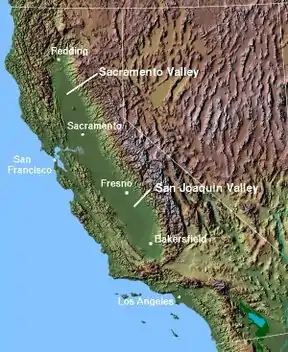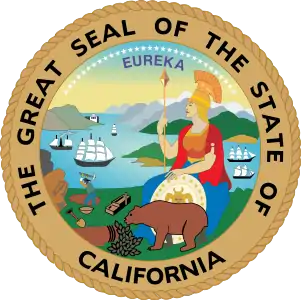Lake Corcoran
Lake Corcoran (also known as Lake Clyde, after Clyde Wahrhaftig, an American geophysicist[1]) is an ancient lake that covered the Central Valley of California.


The lake existed in the valleys of the Sacramento River and the San Joaquin River.[2] An alternate view presumes that the lake covered only the southern parts of the Central Valley.[3] The total surface covered by the lake amounts to about 30,000–50,000 square kilometers (12,000–19,000 sq mi).[4] Buena Vista Lake, Kern Lake and Tulare Lake are remnants of Lake Corcoran.[3]
The lake is the source of the Corcoran Clay,[2] a lacustrine unit of the Tulare and Turlock Lake formations.[5] It also influenced sedimentation off the coast of California.[6]
The lake existed between about 758,000 and 665,000 years ago.[2] Clay deposition rates indicate that the lake lasted for 50,000 to 100,000 years.[7] The Lava Creek Tuff of Yellowstone Caldera and the Bishop Tuff of the Long Valley Caldera were deposited in the Corcoran Clay.[8] Before Lake Corcoran formed, the Central Valley was a bay open to the south via a passage, until 2 million years ago when the bay was separated from the ocean, probably due to northwestward movement of the Coast Ranges along the San Andreas Fault. Subsequently, the valley was no longer a bay and alternately drained and filled with water.[5] The factors contributing to the formation of Lake Corcoran are not fully understood.[9]
The lake originally drained into Monterey Bay[10][6] via the Salinas River,[11] or at times not at all.[2] Evaporation from this lake was a source of water for the Sierra Nevada and in lesser measure for the Basin and Range Province behind it. This contributed to the formation of large pluvial lakes in Nevada.[4]
600,000 years ago a new outlet formed in the present day San Francisco Bay, where it remains today.[6] Sediments found south of San Francisco indicate that by 400,000 years ago the drainage was fully established. The overflow may have occurred at a time where glaciers were melting and when shifts in the jet stream during the marine oxygen isotope stage 6 caused increased precipitation in and runoff to the Central Valley.[2][12] The overflow rapidly carved an outlet through Carquinez Strait, probably catastrophically,[10][11] and drained the lake.[4][12] The Upper Turbidite Unit of the Monterey submarine fan may have formed soon after this outflow, when sediment from the former lake was carried out of its new outlet and down to Monterey Bay by longshore drift.[13][14]
References
- Richard Hilton (29 August 2003). Dinosaurs and Other Mesozoic Reptiles of California. University of California Press. p. 211. ISBN 978-0-520-92845-9.
- Sankey, Julia; Biewer, Jacob; Basuga, Janus; Palacios, Francisco; Wagner, Hugh; Garber, Dennis (1 January 2016). "The giant, spike-toothed salmon, and the "Proto-Tuolumne River" (early Pliocene) of Central California". PaleoBios. 33: 13.
- Saleeby, Saleeby & Pourhiet 2013, p. 406.
- Reheis, Marith (1 September 1999). "Highest Pluvial-Lake Shorelines and Pleistocene Climate of the Western Great Basin". Quaternary Research. 52 (2): 203. doi:10.1006/qres.1999.2064.
- Sarna-Wojcicki et al. 1985, p. 253.
- "NEOGENE". www-odp.tamu.edu. Retrieved 24 December 2016.
- Sarna-Wojcicki et al. 1985, p. 255.
- Negrini et al. 2008, p. 106.
- Saleeby, Saleeby & Pourhiet 2013, p. 418.
- Wong, K. (30 September 2006). "Carquinez Breakthrough: Where Bay and Valley Meet". Bay Nature. Bay Nature Institute. Retrieved 20 January 2017.
- Martin, G. (20 December 1999). "Bay Today, Gone Tomorrow". SF Gate. Hearst Communications. Retrieved 20 January 2017.
- Negrini et al. 2008, p. 107.
- Fildani, Andrea; Normark, William R. (31 May 2004). "Late Quaternary evolution of channel and lobe complexes of Monterey Fan". Marine Geology. 206 (1–4): 217. doi:10.1016/j.margeo.2004.03.001.
- Normark, W. R. (September 1998). "Late Pleistocene channel–levee development on Monterey submarine fan, central California". Geo-Marine Letters. 18 (3): 179–188. doi:10.1007/s003670050066.
Sources
- Negrini, Robert; Baron, Dirk; Gillespie, Janice; Horton, Robert; Draucker, Anne; Durham, Neil; Huff, John; Philley, Paul; Register, Carol (2008). "A middle Pleistocene lacustrine delta in the Kern River depositional system: Structural control, regional stratigraphic context, and impact on groundwater quality" (PDF). Pacific Section AAPG Publication MP48. Retrieved 25 December 2016.
- Saleeby, J.; Saleeby, Z.; Pourhiet, L. Le (1 June 2013). "Epeirogenic transients related to mantle lithosphere removal in the southern Sierra Nevada region, California: Part II. Implications of rock uplift and basin subsidence relations". Geosphere. 9 (3): 394–425. doi:10.1130/GES00816.1. ISSN 1553-040X.
- Sarna-Wojcicki, Andrei M.; Meyer, Charles E.; Bowman, Harry R.; Hall, Timothy N.; Russell, Paul C.; Woodward, Marta J.; Slate, Janet L. (1 March 1985). "Correlation of the Rockland ash bed, a 400,000-year-old stratigraphic marker in northern California and western Nevada, and implications for middle Pleistocene paleogeography of central California". Quaternary Research. 23 (2): 236–257. doi:10.1016/0033-5894(85)90031-6.

